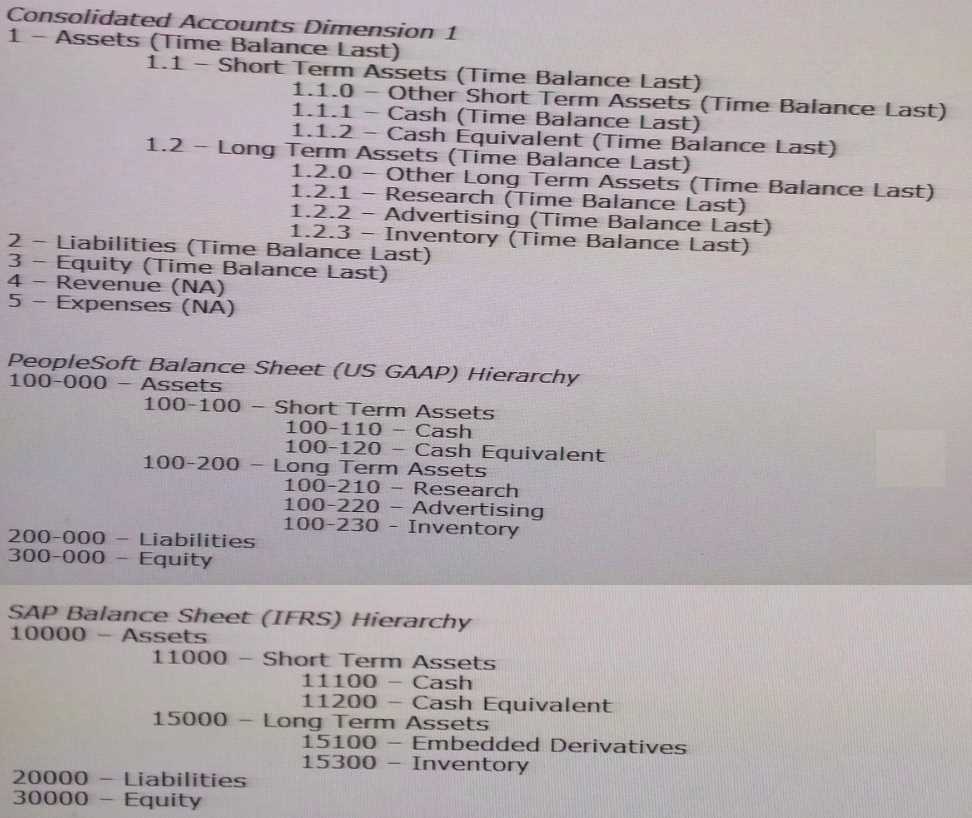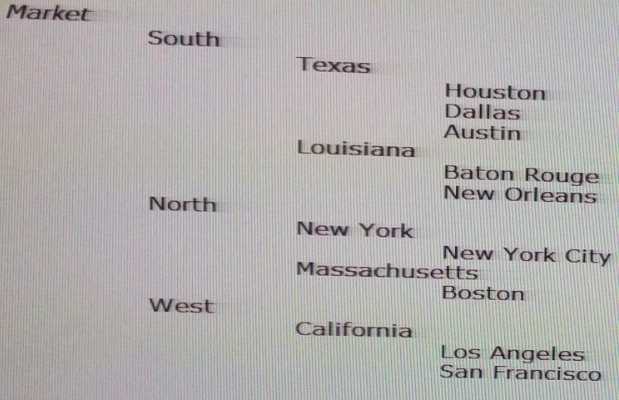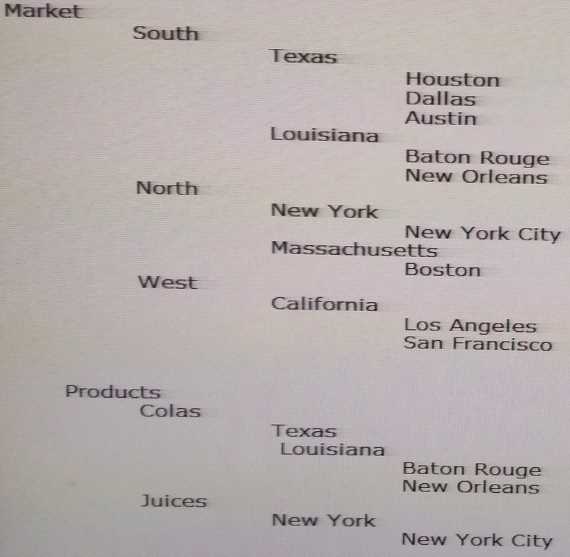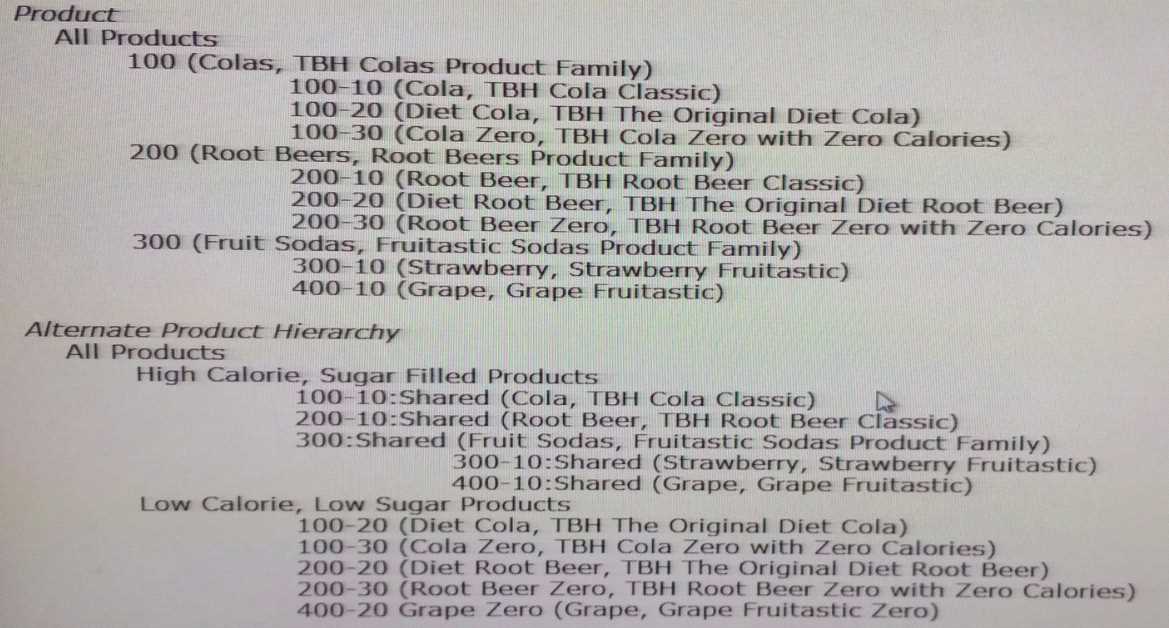oracle 1z0-588 practice test
Oracle Hyperion Data Relationship Management Essentials Exam
Question 1
Which three statements are true about the stakeholders in a DRM implementation?
- A. Business users are initially brought into the project during the testing process.
- B. Source and target systems administrators have minimal involvement during the DRM implementation.
- C. The DRM administrator use both prebuilt and custom property definitions and property categories to create versions and hierarchies as dictated by requirements and design.
- D. The DRM administrator creates validations dictated by requirements and design.
- E. A data governance team defines overall standards for the DRM implementation.
Answer:
ABC
Question 2
You have defined Essbase properties for the First entity, E01. You would now like to apply those same
values to the remaining entity list including siblings and descendants.
What are two ways to complete this step?
- A. Using the Match feature in DRM
- B. Using the Model After feature in DRM for each new entity
- C. Using the Model After feature in an import script
- D. Changing the properties to turn on inheritance
- E. Using the Copy/Put Properties feature for the siblings and descendants of E01
Answer:
AB
Question 3
You are ready to run batch validations against a version before exporting to target systems. Identify
two valid version statuses that allow batch validations to be run and issues to be corrected before the
exports to target systems.
- A. Working
- B. Submitted
- C. Final
- D. Expired
- E. Baseline
Answer:
BC
Question 4
What are the four valid functions available in the DRM Migration utility?
- A. Extract hierarchies and property values from one DRM version.
- B. Extract property definitions, property categories, validations, and queries from a DRM application to an XML file.
- C. Load hierarchies and property values to a DRM version.
- D. Load metadata from an XML file into a Data Relationship Management application.
- E. Compare metadata differences between two sources, such as a development DRM instance to a production DRM instance.
- F. Generate an HTML report from the results.
Answer:
BCEF
Question 5
How can downstream systems receive exported data from DRM?
1. Database query
2. Export
3. Export Book
4. API
5. DRM Migration utility
- A. 2, 3 only
- B. 2, 3, 4 only
- C. 1, 2, 3 only
- D. 1, 2, 3, 4 only
- E. 1, 2, 3, 4, 5
Answer:
A
Question 6
Identify three common issues that are addressed by DRM out of the box.
- A. Physical reconciliation of fact data from transaction systems
- B. No central point of maintenance for a dimension
- C. Hierarchies are maintained by IT
- D. Rationalization of hierarchies across systems
- E. Lengthy reconciliations and manual process to make changes in data relationships
Answer:
BDE
Question 7
Per the example:
Your organization has two ERPs: PeopleSoft (PS) and SAP. Each ERP has its own chart of accounts.
Each chart of accounts is mapped to a consolidated chart of accounts. The Finance department
maintains the consolidated account hierarchy.
Identify the steps in the correct order to manage the mapping of the local chart of accounts in the
consolidated chart of accounts structure using DRM hierarchies.
1. Build the consolidated chart of accounts hierarchy.
2. Build the PeopleSoft and SAP chart of accounts hierarchies.
3. Create a property category called CoA Map with two property definitions: PS CoA Mapping and
SAP CoA Mapping.
4. Create an alternate Market hierarchy with limb nodes "large", "Medium", and "Small". Insert cities
as leaf nodes under the appropriate Market Size nodes.
5. Use the Blend function to merge the PeopleSoft and sap chart of accounts to the correct
consolidated account node In the consolidated hierarchy.
6. Drag and drop the PeopleSoft and SAP chart of accounts to the correct consolidated account in the
consolidated hierarchy.
- A. 1, 2, 3, 4, 5, 6
- B. 3, 1, 2, 4, 6
- C. 3, 1, 2, 5, 6
- D. 1, 2, 4, 6
- E. 4, 3, 1, 2, 5, 6
Answer:
C
Question 8
Select the three options that will complete this sentence to make it a true statement:
"Batch validations in DRM may be run for a_____."
- A. Version
- B. Node Type
- C. Hierarchy
- D. Node
- E. Node and its ancestors
Answer:
C
Question 9
If you want to create an export for the Budget Office to export the Entity hierarchy. Which two steps
must be completed in order to accomplish this?
- A. Make sure that you have Application Administrator access at a minimum.
- B. Create the export and assign security for the export to the Budget Office.
- C. Save the Export as a System object.
- D. Save the Export as a Standard object.
- E. Grant the Budget Office access to the Entity hierarchy.
Answer:
B
Question 10
The images or icons in the first two columns of the properties Tab indicate the following about a
property:
1. Local property or global property
2. Locally inherited or globally inherited
3. Value is overridden
4. Value is default
5. Value is calculated
6. Value is manually entered
- A. 1, 2 only
- B. 1, 2, 3 only
- C. 1, 2, 4 only
- D. 1, 4 only
- E. 1, 2, 3, 4, 6 only
- F. 1, 2, 3, 4, 5 only
Answer:
F
Question 11
You decide to implement node type? for the Account dimension. What are the required steps that
must be completed to implement a node type?
1. Under Administer, create node types with valid assigned DRM elements.
2. Create a hierarchy property that contains a list of values that matches the node types defined.
3. Create a local node property called "HierarchyNodeType".
4. For version, set the HierarchyNodeType to "Dimension".
5. For the hierarchy, set the Dimension property to the desired Node type value (for example.
Account dimension type for the Account hierarchy).
6. Upload a glyph for each node type.
- A. 1, 2, 3, 5 only
- B. 1, 3, 4, 5 only
- C. 1, 2, 3, 4, 5 only
- D. 1, 2, 3, 5, 6 only
- E. 1, 2, 3, 4, 5, 6
Answer:
B
Question 12
You maintain the Market hierarchy in DRM.
A target system needs an alternate hierarchy of the Market dimension that contains the lowest level
of markets (city) rolling up by market size (nodes Large, Medium, and Small).
Identify the ways to meet this requirement in DRM.
1. Create a property category called "Market Size" and populate the values as "Large", "Medium",
and "Small"
2. Create a property called "Market Size" and populate the values as "Large", "Medium", and "Small"
3. Create a node type called "Market Size" and populate the values as "Large", "Medium", and
"Small"
4. Create an alternate hierarchy in the Market dimension with nodes "Large", "Medium", and
"Small". Add cities as shared nodes under the appropriate Market Size nodes.
- A. 1 only
- B. 2 only
- C. 3 only
- D. 4 only
- E. 1, 4 only
- F. 2, 4 only
- G. 2, 3, 4 only
Answer:
D
Question 13
The Data Relationship Management API Adapter is required for the DRM API. Identify three other
components that are required to use the DRM API.
- A. Oracle WebLogic Server 11g
- B. JDeveloper
- C. EPM Workspace
- D. Oracle Web Services Manager (OWSM)
- E. Shared Services
Answer:
CDE
Question 14
Per the Example:
You need to load both the Product and Market hierarchies to multiple Essbase databases.
Identify three DRM objects that could be used across both Product and Market hierarchies?
- A. Common Essbase system properties
- B. Common Essbase system validations
- C. Parent/Child export definitions
- D. Generation export definitions
- E. Level export definitions
Answer:
ABC
Question 15
Per the example:
Identify the two true Statements about the Product hierarchy and its alternate hierarchy.
- A. 300-10 is called an Explicit Shared Node.
- B. 300-10 is called an Implicit Shared Node.
- C. 300 is not a valid shared node because only leaf nodes may be shared.
- D. You can delete the node 300-10 in the alternate product hierarchy,
- E. You can change local property values in the alternate product hierarchy.
- F. You can change any of the system generated property values on the Shared Node property category for the alternate product hierarchy.
Answer:
EF